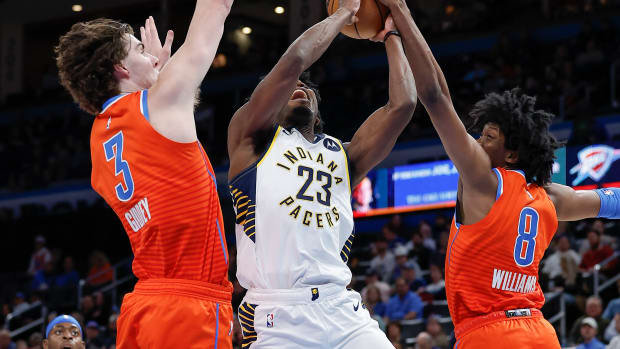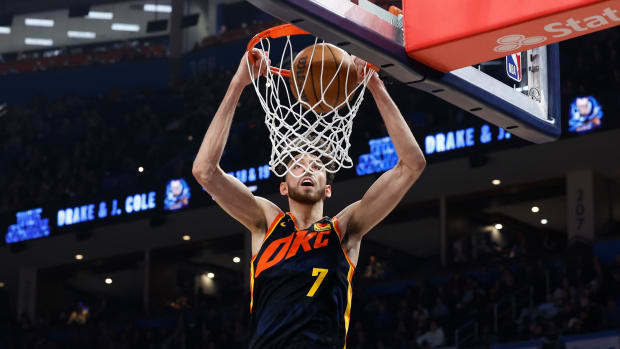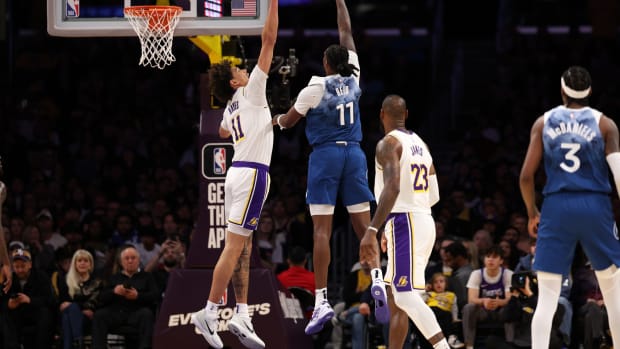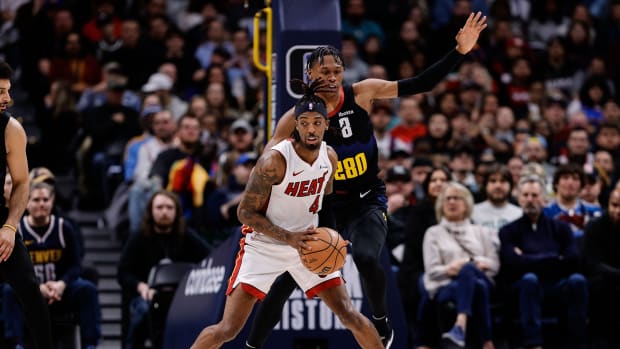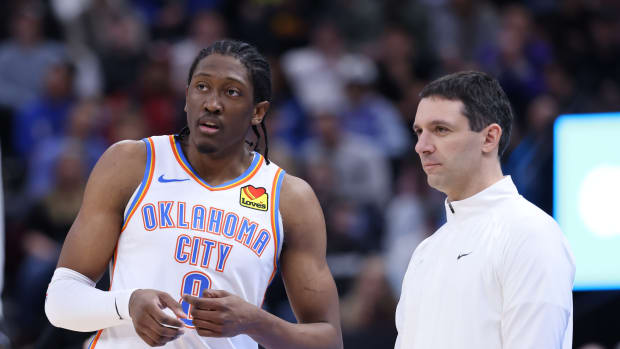How Instagram Conquered the NBA
Deep inside Facebook’s sprawling Menlo Park campus, in a glittering office building flanked by multiple valet stations, resides Instagram’s headquarters. And deep inside Instagram’s headquarters, past the stages where visitors pose to mimic one of Beyoncé’s iconic posts, up the stairway lined with artistic tributes to the company’s rainbow logo, past the vending machines stocked with USB cables, and near the library decorated with archaic cameras and origami, sits the Instagram Sports Partnerships team. All two of them.
Brandon Gayle, a 37-year-old Harvard Business School graduate, shifted to Instagram from Facebook in 2015. Will Yoder, 30, joined Instagram in 2016 from Octagon, where he managed digital operations for the sports and talent agency. Together, they are tasked with advising professional leagues, teams and players around the world on the photo-sharing app’s many functions and capabilities.
That this is somehow a job for just two people, within a company of 700+ employees, seems absurd. After all, Instagram now has more than 240 million sports-seeking users. But the slim set-up reflects Instagram’s ease of use, organic popularity and wide-spread adoption in sports circles. Gayle and Yoder don’t devote much time to twisting arms or hand-holding, instead helping to conceive new initiatives and share best practices culled from years of experimenting and analysis.
While soccer still reigns supreme worldwide, the NBA is Instagram’s shining star domestically. The NBA’s official account has 27 million followers—nearly doubling the NFL’s 10.9 million and MLB’s 4 million combined—and totaled a whopping 3.7 billion video views on the platform last year. LeBron James leads all U.S. athletes with 35.7 million followers, dwarfing Tom Brady’s 3.9 million. And the Warriors lead all team accounts with 8 million followers, more than the Dallas Cowboys (2.5 million), New York Yankees (1.8 million) and Boston Red Sox (1.1 million) combined.
Over the last five years, as it has incrementally added Vine-like video capabilities, Snapchat-like “Stories,” and Periscope-like “Live” streaming, Instagram has become the preferred social-media destination for NBA players. Draymond Green and LeBron James warred on the site during the Warriors’ championship parade, Joel Embiid capped a career night against the Lakers with an Instagram slam of LaVar Ball and, just this week, Kyrie Irving took to the comments to insinuate that Zaza Pachulia was a dirty player.
But the player-to-player conversations—and the media coverage they inevitably draw—are only a sliver of Instagram’s success in NBA circles. The league office believes the app is so influential that its content plan assumes Instagram users have no other access to its games. Teams like the Warriors, Heat and Blazers are using the site’s powerful ad targeting tools to sell tickets and merchandise at rates that far exceed other channels. And the Bucks view Instagram as the preferred vehicle for spreading the growing gospel of Greek star Giannis Antetokounmpo.
“There’s symmetry because the NBA is built on superstars and Instagram is a platform with many public figures,” Gayle told The Crossover during an extended interview at Instagram headquarters. “You don’t see a lot of restrictions on what players can’t do which you might see in other leagues, and the NBA has given broadcasters and digital outlets the right to re-post highlights. There’s a flooding of the market. Other leagues say, ‘less is more’ and try to control the content and create scarcity. The NBA has taken a ‘more is more’ approach, and it’s worked.”
Instagram's Royal Influence
To social media professionals both inside and outside Instagram, LeBron James’s influence on the site rivals his on-court prowess. Instagram has an informal list of qualities it sees in the most successful athlete accounts—star power, authenticity, accessibility, consistency, and outspokenness—and James checks all the boxes.
While a simple “That’s what she said” joke directed at Green was enough to drive an entire news cycle last summer, James sets the standard in many ways. He speaks out on social issues and shows support to Colin Kaepernick. He posts cryptic Arthur memes and self-effacing jokes. He relentlessly plugs his Nike sneakers. He shows love to other players—“Young Kings”—and to his family members. What’s more, he quickly adopted the Stories function, providing fans access to his offseason workouts with self-made video clips. Instagram believes his wide-ranging success has encouraged other NBA players—from stars to scrubs—to hop aboard.
“LeBron is a lighthouse example of great athlete content,” Yoder told The Crossover. “First-person, just him and the phone. He might be giving his mother a Rolex for her birthday, unveiling new music on his drive to the game, or in the gym working out. It’s more compelling because it’s raw and from his perspective.”
James’s full embrace of the platform is representative of an attitudinal shift towards privacy. Long gone are the days of Michael Jordan bunkering down in a fortress-like practice facility or a gated mansion; Now, superstars like James and Stephen Curry raise their children with the cameras on.
In addition to providing his own behind-the-scenes broadcasts, James often lends assists to the NBA’s social media staffers, some of whom he addresses by name. When he knows clips are being filmed for the NBA’s Instagram page, James will specifically point or gesture to the camera. In exchange, he’ll request specific photos or video clips from league staffers—like a left-handed alley-oop against the Lakers—for use on his own page.
That drastic shift in accessibility has become the new normal throughout the league. Ten years ago, a social media reporter was a nuisance to arena security staffers, let alone its superstars. Social media was new and cell-phone video theoretically had damaging potential. Now, the opposite is true: the social media reporter has become the plug for the game’s biggest stars, ready to provide a celebration shot, sneaker pictures or a highlight clip at a moment’s notice.
When Bradley Beal scored a career-high 51 points against the Blazers, John Wall reached out to NBA social for highlights. “Get out of my face” has even been replaced by “Give me a shout out.” Raptors All-Star guard Kyle Lowry recently commandeered a phone belonging to an NBA social staffer to tape a message soliciting followers for his lesser-known backup, Fred VanVleet.
One prominent team’s social media manager crafted a systematic response to the flood of content requests, creating a Dropbox folder for every player to assist with their Instagram needs. The folders, which can also be accessed by wives and girlfriends, are stocked with pictures from Getty Images, behind-the-scenes cell-phone shots, and even family photos. New material is constantly added in batches as the season unfolds. The Instagram beast always demands to be fed.
“It’s the number one place people go for everything now,” said Pistons All-Star center Andre Drummond. “When you put up content, it spreads like wildfire. For me and other NBA players, we post pictures and interact with fans. We go straight to Instagram when we wake up in the morning. People check Instagram real quick.”
How Instagram Won Over the NBA
The older heads in the NBA’s social media community view the 2012 Olympics as Instagram’s arrival moment to professional basketball. It was a harmless and understated beginning, as the star-laden team took prank photos of each other sleeping on planes en route to gold in London.
With Twitter solidified as the go-to spot for NBA coverage at that point, the league, its teams and its players began to see Instagram’s developing potential as an alternative. “NBA Entertainment’s mission for 30+ years has been access-driven, taking our fans behind the scenes,” said NBA VP of Social and Digital Content Bob Carney, who has three personal Instagram accounts. “With social media, the mission is the same. The speed and the delivery mechanism changed.”
Whereas Twitter excelled at two-way interactions, play-by-play updates, breaking news and snark, Instagram emerged as a prettier and mellower alternative. “One of Twitter’s challenges is that it’s often overcaffeinated, hyped up and full of knee-jerk reactions,” said Blazers Chief Marketing Officer Dewayne Hankins. “Instagram allows more time to make the right post. It rewards quality, not quantity, and has less noise.”
The Bucks, like the Blazers, were early adopters, so early that they remember weighing Instagram’s merits against Picplz, a photo-sharing service that was shuttered in 2012. Initially, they favored Picplz because it functioned well on desktop computers. Nine thousand posts later, they’ve come around to Instagram’s mobile-only thinking, and their nearly one million followers outpace Milwaukee’s population of roughly 600,000. “Instagram’s visual approach works for a Giannis dunk,” said Bucks Chief Digital Officer Mike Grahl, “but also a fierce facial expression or pure joy in his smile.”
Eventually, Twitter’s staying power, Instagram’s growth, and the rise of other social media sites like Snapchat forced the NBA to respond from a staffing standpoint. Carney said that the NBA consolidated their social media employees into a single group so that they could “obsesses over content every hour of every day.” The obsession is real. After testing Instagram’s latest algorithm, Carney said, the NBA realized that it risked turning off its followers by posting too often. The league now limits itself to “only 16 or 17” posts per day and pores over its engagement stats, views, likes, and comments, using the data to tweak graphics, select image angles, and craft best practices.
In a recent test, the NBA analyzed two different videos of Kyrie Irving handing out his shoes to a fan, determining that one of the clips had significantly fewer views because the sneaker exchange had been buried a mere eight seconds into the clip. “If you closely monitor your behavior,” Carney said, “you’ll notice that you have one second to grab someone’s attention, or they just keep scrolling.”
After keeping such close tabs on its user behavior, the NBA concluded that its Instagram audience was engaged enough to warrant comprehensive, standalone coverage. Now, followers receive score updates, nightly leaders, top highlights, and behind-the-scenes access without ever needing to visit NBA.com, tune into a broadcast or travel within 5,000 miles of an NBA arena.
Teams adjusted too. The Blazers hired Bruce Ely, the top sports photographer in Oregon, to up their Instagram game. The Bucks started sending Digital Communications Manager Nick Monroe on every road trip so that no post-game celebration would get lost in the shuffle. And the Heat filled out their social media staff under Senior Director of Interactive Media Lauren Cochran, targeting “utility players” who were comfortable posting content across five or more social media platforms.
The NBA clearly delights in the ultra-fan-friendly version of itself that comes through on Instagram. The league’s most viewed posts include a soldier returning home to surprise his family on the court, a family portrait of Kobe Bryant, a post-game hug between LeBron James and Kyrie Irving, and James congratulating Kevin Durant following Game 5 of the 2017 NBA Finals. From a pure public relations standpoint, that softer type of content represents a strong counterbalance to touchier subjects that often go viral, like fights on the court, bad calls by the officials, or embarrassing bloopers.
Instagram has taken steps to positively reinforce that environment. The site now surfaces specific comments to the top, ensuring that players see reactions from their colleagues and favorite accounts without scrolling through thousands of responses, which might include heckling, profanity or worse. Players, agents and teams can also block certain keywords from appearing in their comments altogether. If DeAndre Jordan decided that he no longer wanted to read about “free throws,” that would be the end of it. “Athletes always give feedback about negativity on social media,” Instagram’s Gayle said. “Instagram feels like a kind and polite place, and the players notice that.”
The Next Wave of Social Stars
If LeBron James is the Instagram King, Joel Embiid (1.8 million followers) and Giannis Antetokounmpo (2.4 million followers) are next in line for the throne. Both are certified All-Stars on the court. Both are young enough to be in Instagram’s largest age demographic (18-24). Both were born outside the United States, providing an added appeal to the 80% of Instagram’s monthly active users who aren’t American. And both are genuinely funny, with Embiid trending towards braggadocio and Antetokounmpo coming off almost bashful.
“I’m taking the credit: I have the best social media by far,” Embiid told The Crossover. “I just do what I have to do and then I’m out. I’m the best because I’m a savage. I don’t care. I do whatever I want.”
At All-Star Weekend, Draymond Green saluted Embiid’s “Instagram locations” as the 7-footer’s best skill on or off the court, thereby providing one example of how Embiid’s wit has helped him find his footing despite missing two years to injuries. This season alone, Embiid has launched good-natured barbs towards LaVar Ball, Andre Drummond and Karl-Anthony Towns, deploying his trademark location tags, pithy captions, and withering comments to score points. His targets, opponents, and coaches have all noticed how sharply he’s departed from the longstanding norm of avoiding unnecessary off-court drama. But most viewers read his antics as ultimately harmless.
“Fighting isn’t verbal, face-to-face combat anymore,” 10-time All-Star Paul Pierce told The Crossover. “Fighting is posting a picture of you to Instagram with crazy graphics or with you punching someone in the face. I don’t know if it’s better [than the old days], but it’s a lot safer. Nobody gets hurt.”
With all due respect to Embiid, though, Antetokounmpo appears to be the clearest James successor on the platform. His game is so entertaining that the Bucks saw a 360% traffic increase during the first month they were able to post his highlight clips on their website in 2015. There's no end in sight: Milwaukee's Instagram video views have increased by more than 500 percent in 2017-18 compared to the previous year.
“Visually, he’s mesmerizing,” Yoder said, tabbing Antetokounmpo as one of Instagram’s rising stars. “Whether he’s jumping over Tim Hardaway Jr. or dunking from half-court with three steps, we’ve never seen it before. His background is different from what past superstars. He came to America and things were so different for him. He’s figuring it out as he goes and we’re going along for the ride.”
Antetokounmpo’s wide smile and mischievous personality play equally well on Instagram. Like James, he’s made full use of the platform, regularly posting Stories, using the Live functionality to host video chats with fans, and sharing photos of his family after games or hanging out.
“I like Instagram [over Twitter],” Antetokounmpo told The Crossover. ”I have more followers, that’s why. There are lots of people who can’t watch games or see me in person. It’s a way to show them how I really am, to show them behind the scenes.”
In recent Instagram clips, he giggled while pranking a teammate by filling his car with popcorn, offered his sweatshirt to a fan who was wearing a Big Baller Brand hoodie, and embarrassed his longtime girlfriend by calling himself a “freak on the court and on the sheets” while revealing a risqué Valentine’s Day gift to his followers.
“I definitely got in trouble for that,” Antetokounmpo laughed. “How do you say in the U.S.? 'I’m in the dog house.'”
While his standing as the second-leading All-Star vote-getter is evidence that Antetokounmpo already possesses significant momentum, industry executives believe that his new shoe deal with Nike will provide a substantial boost to his social media visibility. There’s also no telling how high his popularity will climb once he guides the Bucks to the first deep playoff run of his career, whether this year or next.
“It’s an honor [to be considered the next star on the platform], but I don’t post with an agenda,” Antetokounmpo said. “I post because I want my fans to get to know me and I want to document my struggle. … My family, my friends, my country, and my team all mean something to me. If my followers see my dedication and the fun I have along the way, then I feel I am doing the right thing.”
Cashing In
As NBA teams scaled up their social media operations, some faced pushback: Likes don’t necessarily translate to sold out stadiums and video views don’t necessarily translate to jersey sales. Sending staffers on the road for an 82-game season is no small investment, some basketball operations departments are territorial about their privacy, and even the best social media team can be hamstrung by a bad on-court product.
For Instagram’s proponents in the NBA, the addition of the Stories functionality in 2016 was a game-changer. On the most basic level, Stories offered a supplemental alternative to the traditional feed: The NBA and its teams could tell narrative stories picture-by-picture or clip-by-clip without spamming their followers’ feeds. Big games could now be covered from four hours prior to tip—when maniacs like Ray Allen show up to shoot—to the last step onto the team bus. The walk-in fashion show became a nightly ritual, unique pre-game routines like Stephen Curry’s went under the microscope, in-the-huddle video clips complemented traditional broadcasts, and post-game sound bytes were transmitted instantly.
But the biggest development from Stories was its potent advertising capabilities. For years, Instagram had prevented users from posting links to outside websites to maintain its quality standard. Stories, however, allowed users to swipe up and click out to an external website, allowing teams to plug their ticket sites and online stores. Stories is also user-activated and fills the entire face of a smartphone, meaning users actively click into the advertising environment and then are fully immersed in the experience. That beats a website banner ad or sponsored text in another app.
“Platforms get cluttered because the platform allows it or because advertisers are there in droves,” said the Bucks’ Grahl. “Instagram, and particularly Stories, is not as common of an advertising platform right now and it’s enjoying a really nice honeymoon phase.”
Instagram, which is owned by Facebook, also incorporates the parent company’s thorough user information database and powerful advertising program. Teams are therefore able to segment their fan bases by demographics or behavior, target “lookalike” users, and track the effectiveness of their campaigns using their Business Manager accounts. For teams that advertise on both sites, Facebook Sports’ 35-member staff provides cross-app marketing advice.
The Heat utilize Stories to sell tickets and to promote major campaigns, like their comprehensive rollout of their well-received “Miami Vice” jerseys. Instagram’s tracking capabilities allows Miami’s staff to determine whether fans are purchasing directly from the Heat or from a secondary ticket seller, which piece of merchandise prompted a click, and whether the user purchased that same item or something else.
“We’re running over 400 ads right now,” said the Heat’s Cochran. “We do testing on steroids. We watch how they all perform. We toggle them on and off to optimize for the best images and videos. It’s like day trading. You sit there and watch it in real time. Our digital strategist is consumed by it. It’s like a game to him.”
For reference, multiple NBA marketers pegged a 5 to 1 return on ad spending as a successful benchmark. Even before Dwyane Wade’s much-celebrated return to Miami earlier this month, Instagram ads had delivered an 8 to 1 return for the Heat in retail sales and a 14 to 1 return on ticket sales in January.
The Warriors used Stories to help push their “Slate Night” jerseys, altering the color scheme of their page to mimic the in-arena experience. During the game, Golden State tracked every user that interacted with one of the “Slate Night” images or videos. After the game, they served that group an ad for a “Slate” Stephen Curry jersey. The strategy delivered a 13 to 1 return.
Portland has found similar success targeting their ads around key moments, like a C.J. McCollum game-winner against the Spurs. The Blazers packaged their ads around multiple images of the shot, infographics celebrating the victory, and a slow-motion video that showed the shot and the crowd’s jubilant reaction. Portland’s Instagram campaigns generally return at a rate of more than 13 to 1; the ads shown during the afterglow of McCollum’s game-winner delivered a 34 to 1 return.
Not surprisingly, Portland has shifted more than half of its total marketing budget to digital advertising, with Instagram receiving a significant and growing chunk of that money. The Heat and Bucks said they have reallocated in similar fashion this season.
Now What?
Successful Silicon Valley companies naturally focus more attention on what’s next rather than what’s now, and they’re notoriously secretive about their plans. Gayle and Yoder offered no specific teasers, and NBA executives weren’t exactly pushing for radical changes. “It’s impossible to know what’s next,” said the NBA’s Carney. “Instagram doesn’t tip its hand very often. We’re all one app update or algorithm change away from having to adjust.”
Some of the requested Instagram tweaks from NBA team staffers included: A more prominent method for attributing content to specific photographers and videographers, a more sophisticated ability to sort accounts into lists, and a clearer understanding of why Instagram’s latest algorithm occasionally surfaces content that is two or three days old.
While many users find the new algorithm frustrating because it is no longer purely chronological, Gayle said that company’s approach has “proven to improve the experience” because “we could see in the data and hear from users that they were missing a ton of content they wanted to see.” Instagram determines what content a user is most likely to want based on posts they have engaged with and accounts they interact with regularly. That approach is apparently here to stay.
The Case for the NBA Lottery Tournament
When that day comes, the two-man team of Gayle and Yoder are ready to assist. “We’re essentially free consultants,” Gayle said. “We let NBA players and teams know what tools are available to reach their personal and business objectives. When you look at the NBA’s demographics and our demographics, their global ambitions and our global platform, it’s been a perfect marriage.”

































